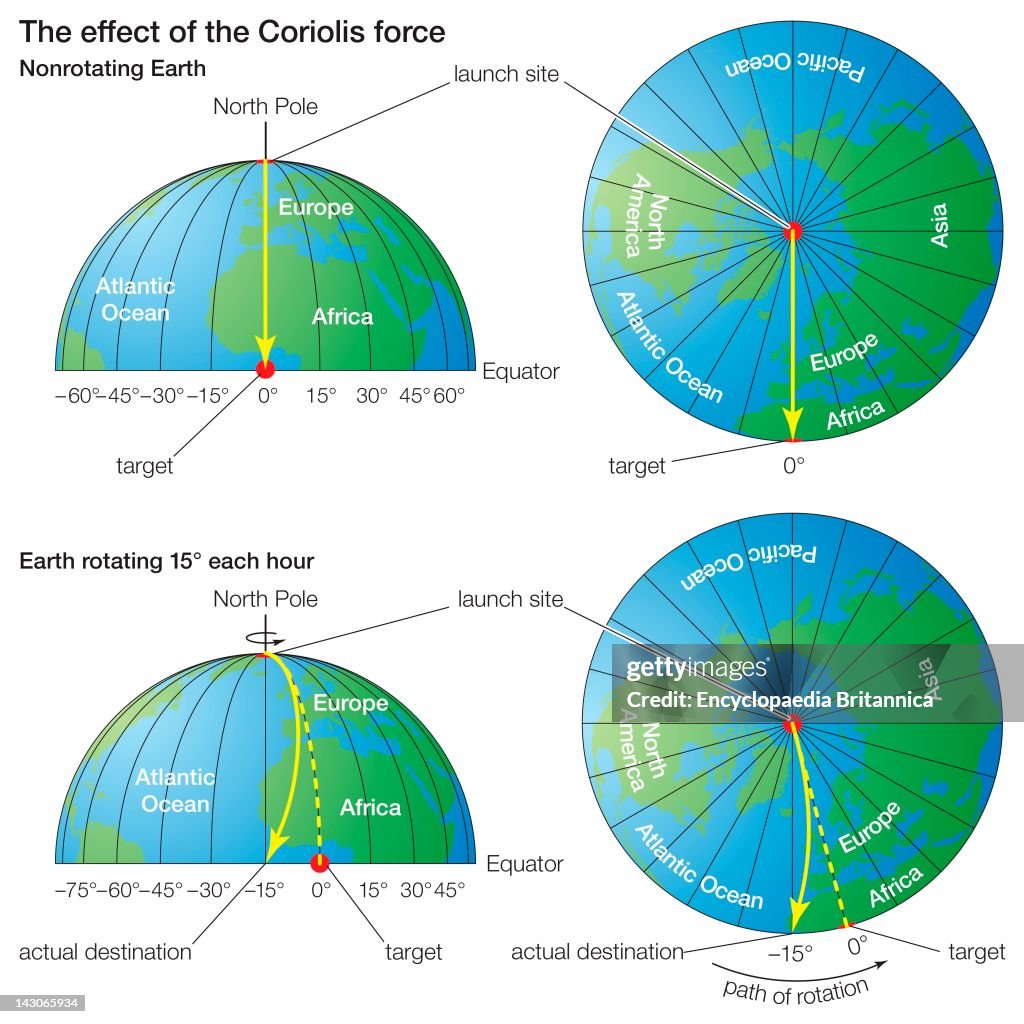The Coriolis effect, also known as the Coriolis force, is an apparent deflection of the path of a moving object that occurs when the object is observed from a rotating reference frame. It is named after the French mathematician and physicist Gaspard-Gustave de Coriolis, who first described it mathematically in the 19th century. The Coriolis effect is most commonly experienced in the context of weather systems and ocean currents on the Earth. As the Earth rotates on its axis, any object or fluid moving horizontally across its surface is subject to the Coriolis effect.
The Coriolis effect causes moving objects to be deflected to the right in the Northern Hemisphere and to the left in the Southern Hemisphere. The magnitude of the deflection depends on the speed of the object, the latitude of its position, and the duration of its motion. The effect is strongest at the poles and decreases towards the equator. The Coriolis effect arises due to the difference in rotational velocity at different latitudes. Points closer to the poles travel a shorter distance in a single rotation than points closer to the equator. As a result, an object moving from one latitude to another will appear to be deflected due to the difference in rotational speed. This deflection is not an actual force but an apparent force resulting from the rotation of the reference frame.
In addition to its influence on weather systems and ocean currents, the Coriolis effect also affects the trajectory of moving objects such as projectiles, airplanes, and even the flight of sports balls. For example, in long-range ballistic missile trajectories, the Coriolis effect needs to be taken into account to ensure accurate targeting.
Why Is The Coriolis Effect Zero At The Equator?
The Coriolis force is an apparent force that appears to act on moving objects in a rotating reference frame, such as the Earth. It deflects the motion of objects to the right in the Northern Hemisphere and to the left in the Southern Hemisphere. At the equator, the Coriolis force is effectively zero or very close to zero. This is because the Coriolis force is dependent on the rotation of the Earth and the rate at which an object is moving relative to the Earth's rotation.
The Coriolis effect is rooted in the rotation of the Earth. The Earth's rotation speed varies depending on the latitude. At the equator, where the Earth is widest, the rotational velocity is the highest. In a single 24-hour period, the equatorial regions travel at a remarkable speed of nearly 1,600 kilometers (1,000 miles) per hour. On the other hand, near the poles, the rotational velocity is significantly slower, approximately 0.00008 kilometers (0.00005 miles) per hour.
The Earth rotates around its axis, completing one full rotation in approximately 24 hours. The rotational velocity is highest at the poles and decreases gradually towards the equator. The Coriolis force is proportional to the rotational velocity of the Earth. At the equator, the rotational velocity of the Earth is highest, but the rate at which an object moves due to the Earth's rotation is also highest. The Coriolis force is given by the equation F = 2mωv, where F is the Coriolis force, m is the mass of the object, ω is the angular velocity of the Earth's rotation, and v is the velocity of the object.
Since the velocity of an object at the equator is highest due to the Earth's rotation, the Coriolis force is effectively canceled out or negligible. Therefore, the Coriolis force is considered to be zero at the equator. It's worth noting that the Coriolis force becomes more significant as you move away from the equator towards the poles, where the rotational velocity of the Earth is lower and the rate at which an object moves due to the Earth's rotation is relatively higher.
Why Coriolis force is zero at equator and maximum at poles?
The Coriolis force is zero at the equator because the rotational velocity of the Earth is highest at the equator, but the rate at which an object moves due to the Earth's rotation is also highest. This cancels out the Coriolis force or makes it negligible. The force is maximum at the poles because the rotational velocity is lower, and the rate at which an object moves due to the Earth's rotation is relatively higher.
Is the Coriolis force at the equator?
Yes, the Coriolis force is effectively zero at the equator. As mentioned earlier, the rotational velocity is highest at the equator, but the rate at which an object moves due to the Earth's rotation is also highest. This results in the Coriolis force being canceled out or negligible.
What causes the Coriolis effect on equator?
The Coriolis effect at the equator is mainly caused by the difference in rotational velocity at different latitudes. The Earth's rotation causes a deflection in the path of moving objects, but at the equator, the high rotational velocity and the high rate of movement due to Earth's rotation effectively nullify the Coriolis force.
Is Coriolis force zero at ITCZ?
The Coriolis force is not zero at the Intertropical Convergence Zone (ITCZ). The ITCZ is a low-pressure area near the equator where the trade winds from the Northern and Southern Hemispheres converge. As air converges and rises in the ITCZ, it creates a zone of low pressure. The Coriolis force influences the direction of the winds in this region, causing them to curve to the right in the Northern Hemisphere and to the left in the Southern Hemisphere. Therefore, the Coriolis force is present and plays a role in the dynamics of air movement within the ITCZ.







No comments:
Post a Comment